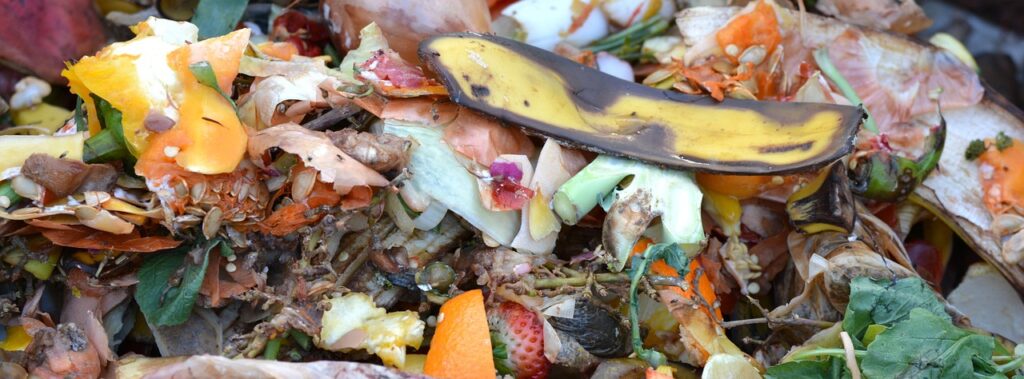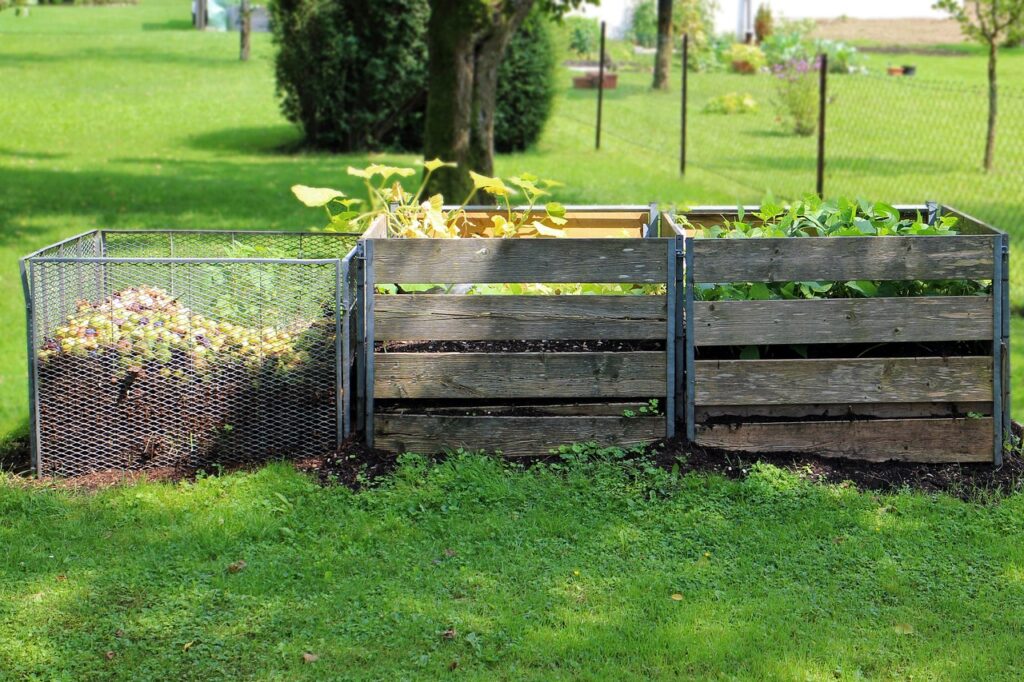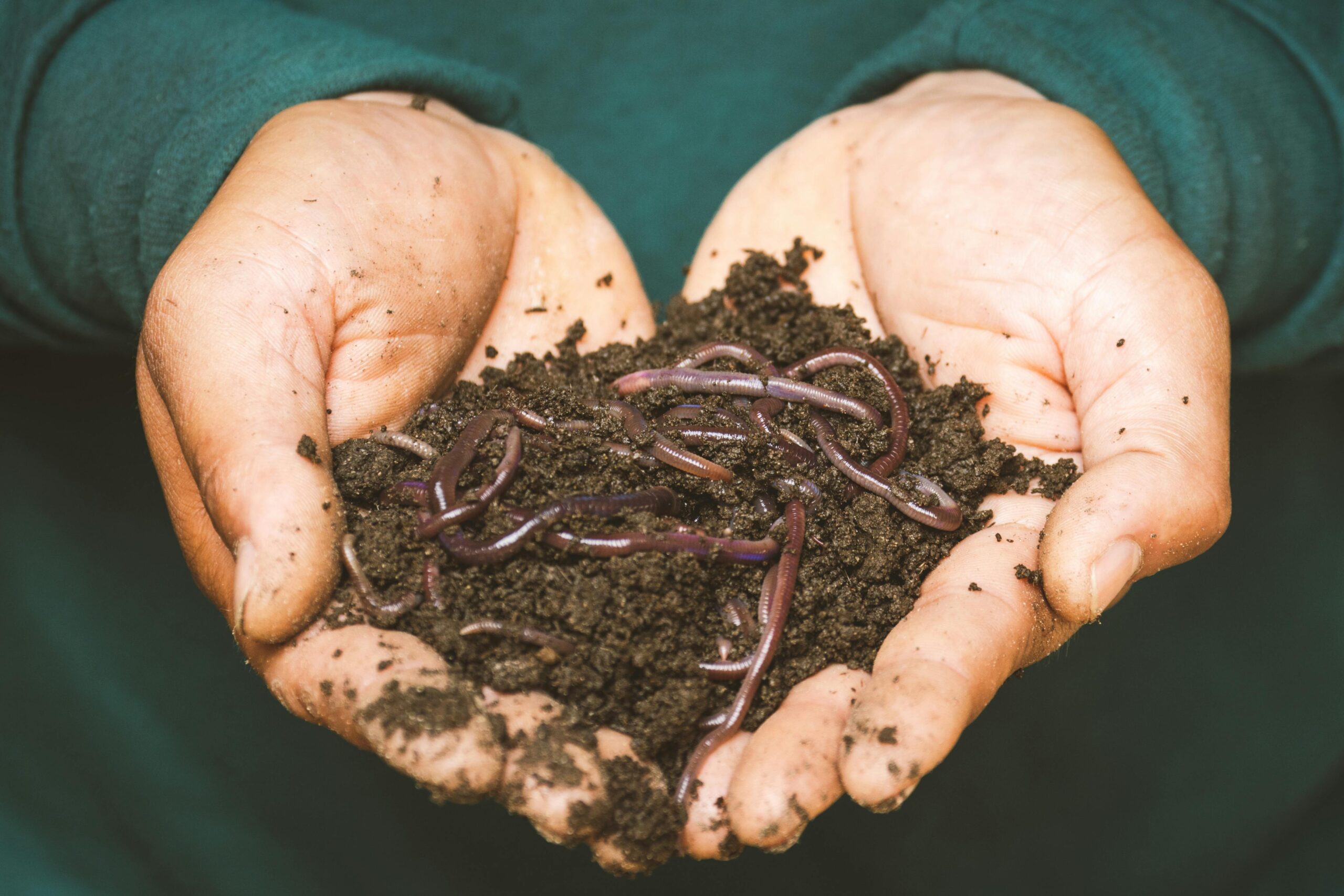If you know me at all, you know that composting is one of my absolutely favorite things to do. Who wouldn’t want to transform kitchen and garden waste into a treasure trove of nutrients, which then becomes a rich additive for the soil that enhances growth and vitality in plants [1]? And anyone can do it! Unraveling the basics of composting couldn’t be easier, and I’d love to help you get started.
Not only does this age-old method of recycling organic matter contribute to the health of our gardens, it’s a small but mighty step toward reducing landfill waste and curbing soil erosion [2]. It’s an important way to help take care of this beautiful earth that God has given us. With a few simple guidelines, anyone can convert food waste and yard trimmings into food for the earth while addressing the broader implications of climate change [2].
Understanding composting begins with recognizing its role in sustaining soil health through the natural decomposition process. This introduction will lay the groundwork for what composting involves, from the basics of mixing green and brown materials to achieve the ideal carbon-to-nitrogen ratio, to the beneficial presence of earthworms and microorganisms hard at work within your compost pile [2]. But don’t worry- it’s not complicated!
Whether you’re aiming to implement waste reduction in your household or excited to discover what compost is used for, this article will provide practical tips for starting, maintaining, and reaping the full environmental benefits of your very own compost system [2].

Getting Started with Composting
To kickstart your composting journey, here’s a step-by-step guide that is both informative and easy to follow, ensuring you’re excited about the process from the get-go:
1. Choose Your Compost Location and Container
- Select a Site: Find a convenient spot in your yard out of full sun to prevent the compost from drying out [5]. It should be partially shaded, directly on soil, and sheltered from extreme temperature changes [9].
- Prepare Your Bin: You can use structures like pallets, cinder blocks, or tumblers to contain the compost [4]. For larger spaces, a bin with a capacity of one cubic meter or more is ideal [9].
2. Gather Your Composting Materials
- Brown Materials: Stock up on carbon-rich browns such as dry leaves, wood chips, and shredded paper [7][2].
- Green Materials: Collect nitrogen-rich greens like kitchen vegetable scraps and grass clippings [7][2].
- Avoid Certain Items: Steer clear of meat, dairy, greasy foods, and diseased plants to prevent attracting pests and creating odors [6][2].
3. Build Your Compost Pile
- Base Layer: Start with a layer of branches or twigs to promote airflow at the bottom of your compost pile [3][5].
- Layering: Alternate between green and brown materials, aiming for a ratio of 3 parts brown to 1 part green [8][5]. Each layer should be 2 to 4 inches thick [4]. But don’t sweat the ratios, anything will work to get started.
- Size Matters: Ensure your pile is at least 3 feet square to generate enough heat, but no higher than 5 feet, for ease of maintenance, and best decomposition [3].
4. Maintenance
- Moisture Control: Keep the pile moist but not soggy by dampening each layer as you add it [3]. Regular watering is necessary, but avoid excess moisture [4].
- Aeration: Turn or aerate the compost with a fork every week or two to maintain oxygen levels [5].
- Monitor: Check your compost every other week to aerate, moisten, and observe its progress [3].
5. Composting Tips
- Size Reduction: Chop or shred waste materials to speed up decomposition [5][7].
- Material Ratio: Maintain a healthy mix of green and brown materials with a ratio of six inches of brown to two to four inches of green [3].
- Covering: Protect your pile by covering it with soil or closing the lid if you’re using a bin [3].
By following these steps, you’ll be well on your way to creating your very own nutrient-rich compost that will benefit your garden and the environment. Remember, composting is not just about waste reduction; it’s a proactive step towards nurturing soil health and supporting the natural cycle of growth and renewal [2][4][7]. And it’s really, really fun!
What to Compost: Green and Brown Materials
Creating the perfect compost mix is like preparing a gourmet meal for your garden. The key ingredients for a thriving compost pile are the ‘greens’ and ‘browns’—each playing a crucial role in the composting recipe.
Green Materials: Your Compost’s Nitrogen Source
- Kitchen Scraps: Add a zest of fruit and vegetable scraps to inject essential nitrogen into your compost [3][13][12][11][10].
- Yard Waste: Fresh grass clippings and green leaves not only add nutrients but also help maintain moisture levels [3][13][10].
- Coffee and Tea: Used coffee grounds and tea bags are like a shot of espresso for compost, accelerating the decomposition process [3][13][12].
- Egg Shells: Crushed egg shells add a sprinkle of calcium, helping to create a balanced diet for your compost [3][12].
Brown Materials: Your Compost’s Carbon Source - Fallen Leaves: Dry leaves and grasses are the bread and butter of your compost, providing a rich carbon source [3][13][10].
- Shredded Newspaper: Non-glossy shredded newspaper acts as a brown layer, helping to absorb excess moisture and keep the pile aerated [3][13][10].
- Wood Products: Small twigs, sawdust, and wood chips are like the slow-release carbs of your compost, decomposing over time and providing structure [3][13][12].
What to Avoid: Keeping the Balance - Say No to Glossy Paper: Avoid glossy paper, as it may contain inks and coatings not suitable for composting [14].
- Skip the Dairy and Meat: Dairy products, fats, and meat can attract pests and create unpleasant odors [15].
- Avoid Diseased Plants: Adding diseased plants may not reach the temperatures required to kill pathogens, potentially spreading disease back into your garden [15].
Remember, the secret to a successful compost pile is all about balance—aim for a mix of greens and browns to keep your microorganisms happy and your compost cooking. By following these guidelines, you’re on your way to creating black gold for your garden, full of life and ready to support a thriving ecosystem [1][9][4].

Maintaining Your Compost Pile
Maintaining a compost pile is akin to nurturing a garden; it requires attention, balance, and a touch of finesse. Here are actionable steps to ensure your compost pile thrives:
- Balance Your Browns and Greens:
- Aim for an optimal ratio of 2 parts browns to 1 part greens by volume [16].
- Seasonal changes may dictate adjustments in the ratio, depending on material availability [16].
- If odors arise, such as a vinegar or ammonia smell, it’s time to add more browns [16].
- Conversely, if the pile is inactive, boost it with more greens and perhaps a sprinkle of water [16].
- But don’t stress! The materials will break down eventually, even if you don’t do anything.
- Moisture and Smell Check:
- The compost should feel as moist as a wrung-out sponge—neither too dry nor too wet [16].
- A healthy pile emits a mild, earthy smell, indicating a well-managed process [16].
- Aeration and Size Considerations:
- Ensure your compost gets enough air by turning the pile regularly, which also helps manage moisture levels [17].
- Keep the pile size within the sweet spot—minimum 3 feet by 3 feet for warmth generation and maximum 5 feet by 5 feet to allow air to the center [15][17].
Here are some additional tips to maintain the excitement and efficiency of your composting adventure:
- Stash Extra Materials: Keep a reserve of straw, dry leaves, or peat moss nearby to easily adjust the carbon-to-nitrogen (C/N) ratio as needed [16].
- Cover for Success: Use a tarp or similar covering to deter pests, retain heat, and control moisture, especially in cooler climates [17].
- Turning Tactics: Regular turning not only aerates but also moves materials from the edges to the center, speeding up the process [18]. A compost aerator tool can reduce the effort involved [18].
By adhering to these steps, you’ll foster a compost pile that is not just a place to throw out food, but a living, breathing ecosystem excitedly working to produce black gold for your garden.
Troubleshooting Common Compost Problems
Troubleshooting common compost problems can be quite straightforward once you recognize the signs and understand the solutions. Here’s how to keep your compost pile thriving:
Compost Pile Won’t Heat Up
- Cause: It might be too dry, low in nitrogen, or too small [1].
- Solutions:
- Moisture: Ensure the pile is kept moist to facilitate decomposition [1].
- Nitrogen Boost: Add green materials like grass clippings or kitchen scraps to increase nitrogen [1].
- Size Matters: Check that your pile is at least 3 feet on each side and 3 high to generate sufficient heat [1].
Soggy or Smelly Compost
- Cause: Overly wet compost can lack oxygen, leading to foul odors [9].
- Solutions:
- Aerate: Turn the pile to introduce air and kick-start the composting process [9].
- Add Browns: Incorporate carbon-rich materials such as straw or dry leaves to absorb excess moisture and balance out nitrogen [9].
Coarse or Incomplete Compost
- Cause: Some items in your compost may take longer to break down [1].
- Solutions:
- Size Reduction: Shred or chop materials before adding them to your compost to speed up decomposition [1].
- Sifting: Pass finished compost through a screen and return larger pieces to a new pile [1].
Too Wet or Too Dry
- Wet Compost: If your compost is too wet, it can lead to unpleasant odors and attract flies [1].
- Balance: Add more browns to the greens, improve drainage, and fluff up the pile to prevent compacting [1].
- Dry Compost: A compost pile that’s too dry won’t decompose effectively [1].
- Rehydrate: Moisten the pile with water, ideally rainwater, and mix in fresh materials to balance the dryness [1].
Attracting Pests
- Rehydrate: Moisten the pile with water, ideally rainwater, and mix in fresh materials to balance the dryness [1].
- Cause: A compost pile may attract various pests from fruit flies to raccoons [1].
- Solutions:
- Chop Materials: Ensure compost materials are small to speed up decomposition and reduce attraction [1].
- Cover Fresh Greens: Place a layer of browns over new green additions to mask odors [1].
- Mesh Covering: Use a mesh screen to cover the heap and deter pests [1].
Temperature Troubles
- Cause: The ideal compost pile temperature is between 140°F and 160°F. Deviations can slow down the process [1].
- Solutions:
- Too Cool: Add more nitrogen-rich materials to raise the temperature [1].
- Too Hot: Stir the pile to distribute heat and consider insulating it in colder weather [1].
By addressing these common issues, you’ll help ensure your compost remains a nutrient-rich, soil-like substance that’s excited to nourish your garden [9]. Remember, mature compost can be used in a variety of ways, from making potting soil to enriching garden beds, so it’s worth the effort to keep it in top condition [1].
Conclusion
Embarking on the composting journey harnesses the potential of organic waste, transforming it into valuable nutrients for a thriving garden. We’ve explored the basics of establishing a compost system, the delicate balance of green and brown materials, and the maintenance routines that ensure a bountiful, earth-friendly harvest. This process not only enriches the soil but also embodies an active commitment to environmental stewardship, reducing landfill waste, and promoting sustainable living.
As we conclude, remember that the excitement of creating your own compost is just the beginning. The ongoing benefits extend far beyond the garden, touching the very essence of ecological responsibility. And with the foundation laid out in this guide, you are now equipped and ready to start composting today! By nurturing your compost pile, you join a community of soil-health advocates excitedly leading the charge t a greener future.
FAQs
Q: How does one begin the composting process?
A: To initiate a compost pile, first clear a spot of bare soil in your yard or garden. Begin with a foundational layer of straw or twigs. Then, add your compostable materials in alternating layers of ‘browns’ (carbon-rich materials) and ‘greens’ (nitrogen-rich materials). Introduce a nitrogen source to kickstart the decomposition process, and ensure the pile remains damp.
Q: Can you explain the fundamentals of composting?
A: Certainly! Composting is an aerobic process, meaning it requires oxygen to transform organic materials into compost. This process is controlled and natural, resulting in a stable, nutrient-dense soil amendment or mulch through the breakdown of organic matter.
Q: What are some beginner tips for composting at home?
A: For those new to composting, here’s a simple guide: Start by placing your compost pile directly on the ground to allow earthworms and other beneficial organisms to aerate the compost. Begin with a layer of twigs or straw, then add your compost materials in alternating layers of wet and dry. Incorporate a nitrogen source like manure or green manure to help the pile decompose. Keep the pile moist throughout the process.
Q: What does composting mean?
A: Composting is the process where organic matter, such as leaves and food waste, is recycled naturally into a valuable fertilizer. This enriches the soil and provides nutrients to plants, effectively turning waste into a resource.
References
[1] – https://rodaleinstitute.org/blog/backyard-composting-basics-a-cheatsheet/
[2] – https://www.epa.gov/recycle/composting-home
[3] – https://www.sierraclub.org/sierra/2012-6-november-december/green-life/composting-101-hooray-black-brown-and-green
[4] – https://extension.wvu.edu/natural-resources/soil-water/composting-for-beginners
[5] – https://www.environment.sa.gov.au/goodliving/posts/2019/05/guide-to-composting
[6] – https://dontwastethecrumbs.com/composting-basics-for-beginners/
[7] – https://www.homemadesimple.com/beyond-the-home/essential-compost-tips-for-beginners/
[8] – https://www.bobvila.com/articles/composting-101/
[9] – https://mashable.com/article/beginners-guide-to-composting
[10] – https://www.thespruce.com/composting-greens-and-browns-2539485
[11] – https://gardening.stackexchange.com/questions/3313/what-are-good-sources-for-large-quantities-of-greens-for-my-compost
[12] – https://green.fandom.com/wiki/List_of_compostable_materials
[13] – https://www.co.calumet.wi.us/635/Green-Brown-Compost
[14] – https://germaniainsurance.com/blogs/post/germania-insurance-blog/2020/04/28/how-to-compost-a-beginners-guide-to-composting-basics
[15] – https://www.extension.iastate.edu/news/yard-and-garden-constructing-and-managing-compost-piles
[16] – https://www.quora.com/What-is-the-best-ratio-of-browns-to-greens-for-a-home-made-compost-pile
[17] – https://aggie-horticulture.tamu.edu/earthkind/landscape/dont-bag-it/chapter-4-building-and-maintaining-a-compost-pile/
[18] – https://www.planetnatural.com/composting-101/making/pile-maintenance/
[19] – https://www.motherearthnews.com/organic-gardening/maintaining-a-healthy-compost-pile-zmaz97fmzgoe/
[20] – https://compostingtechnology.com/best-ways-to-maintain-moisture-in-compost-piles/
[21] – https://www.oregonmetro.gov/tools-living/yard-and-garden/composting/tips-composting-success


How often can biorevitalization procedures be performed? Biorevitalization procedures can be repeated every 3-6 months depending on individual characteristics and doctor’s recommendations
биоревитализация лица фото https://biorevitalizaciyaa.ru .
Профессиональные советы по чистке кожаной мебели на дому, для поддержания кожи в отличном состоянии.
Химчистка кожаной мебели проводится с использованием безопасных и качественных химических составов, гарантируя безупречный результат: http://www.ximchistka-kozhanoj-mebeli.ru .
“Какие побочные эффекты могут быть после лазерного удаления папиллом?” – “Возможные побочные эффекты включают покраснение, отек, незначительную боль и временные изменения пигментации кожи.”
“What are the possible side effects after laser removal of papillomas?” – “Possible side effects include redness, swelling, minor pain, and temporary changes in skin pigmentation.”
папилломы удаление лазером цена https://udalenie.com.ru/ .